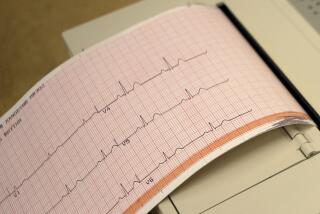Information technology holds promise for advancing healthcare
- Share via
VERO BEACH, FLA. — A stethoscope with three tiny koalas dangling from his neck and eyeglasses perched on his nose, Dennis Saver looks every bit the family doctor as he steps into the examining room of his small practice on Florida’s Treasure Coast.
When Saver begins to examine his patient, however, the 56-year-old physician does something that four out of five doctors in America do not: He pulls out a computer.
The little black Toshiba, its edges worn to the bare metal, gets more use than the stethoscope and has become key to the care Saver gives his patients -- organizing medical histories, test results, prescriptions and other data that were once a jumble of paper records.
Saver’s laptop, and the system behind it, put him on the cutting edge of what President Obama and many experts say is a critical step to improving the nation’s healthcare system while also reining in costs.
It is known as “Health IT,” an idea that promises to use information technology to cut medical errors, avoid unnecessary tests and procedures and identify better treatments. The Obama administration is betting that $19 billion of the economic stimulus package will spread the concept from coast to coast.
Saver and the nine other physicians in his practice decided to take the plunge 3 1/2 years ago.
Gone are tens of thousands of manila files that filled a big room in their office. Doing away with those has allowed the practice to cut its record-keeping staff from seven to three.
The office eliminated 2 1/2 more positions in the billing department because clerks no longer have to struggle over doctors’ handwritten notes.
In the examining room, Jim Culleton -- an 84-year old retiree who cheerfully explained that Saver had saved his life three times -- teased the doctor about his incessant tapping on the laptop.
“I liked it better when he talked into his tape recorder. Now, I don’t know what he’s saying about me,” Culleton said.
“Well, I don’t lose your chart anymore,” Saver countered. “And I don’t throw my back out hauling around your file.” The laptop also allows Saver to quickly check lab results -- in Culleton’s case alleviating concerns about a possible infection, something that could be deadly for the recent heart attack victim.
And costly tests aren’t repeated because a lab result is lost or an image is misplaced, Saver said.
Thanks to warnings embedded in the electronic health record, or EHR, Saver can monitor his patients’ prescriptions to avoid harmful interactions. In case of a recall, he can check the database in minutes to find out whom to notify.
Elsewhere, there are even more promising signs.
Childrens Hospital Los Angeles, which installed an electronic record system five years ago, has all but eliminated errors in prescriptions, according to hospital officials.
In Hawaii, Kaiser Permanente reported a 26% drop in patient visits after the hospital giant implemented an electronic record system that allows doctors and patients to communicate more easily by telephone or e-mail for routine contacts.
And in New York, where the city has helped family practices install EHR systems, doctors are able to turn to their computers for guidance on recommended treatments.
The New York system, which links more than 800 providers, also allows public health officials to quickly tap patient data to track disease outbreaks and send doctors up-to-the-minute advisories.
“There are just huge opportunities here,” said Farzad Mostashari, an assistant health commissioner in New York.
But those opportunities have proved difficult to realize for most American doctors.
A big barrier to wider adoption has been the upfront expense. Installing electronic record systems can cost more than $30,000 per physician.
Even when doctors buy a system, they can’t be sure it will be compatible with other providers’ systems.
If Saver sends a patient to the hospital down the street or a specialist across the parking lot, someone in the office has to fax or e-mail the file. When the patient comes back, records generated elsewhere must then be attached to the patient’s electronic record back at Saver’s office. Three people do virtually nothing else all day.
The federal stimulus package contains grants and financial incentives for those who use electronic records.
But the Obama administration faces difficult decisions about ensuring that the billions of dollars of federal money are not wasted on systems that don’t work or cost too much. Also unresolved is access to patient data, an issue that raises questions about how researchers, pharmaceutical companies, insurers, even patients can use the electronic files.
By the end of the year, the Department of Health and Human Services is to develop a set of standards dictating not only what electronic health records should do, but who should control them and how.
All the while, government officials will have to navigate among a growing number of vendors maneuvering for a piece of the multibillion-dollar pot.
“We’re kind of at the Oklahoma land rush,” said Neal Patterson, founder and chief executive of Cerner, one of the country’s leading health information technology companies.
Patterson and other established vendors contend that Washington must require EHRs to provide a full range of services. Others, warning of Soviet-style central planning, argue for fewer standards to allow quicker adoption of less expensive, if less comprehensive systems.
“The standards are good enough. The technology is good enough,” Mostashari said. “We can’t waste any more time.”
--
More to Read
Inside the business of entertainment
The Wide Shot brings you news, analysis and insights on everything from streaming wars to production — and what it all means for the future.
You may occasionally receive promotional content from the Los Angeles Times.











